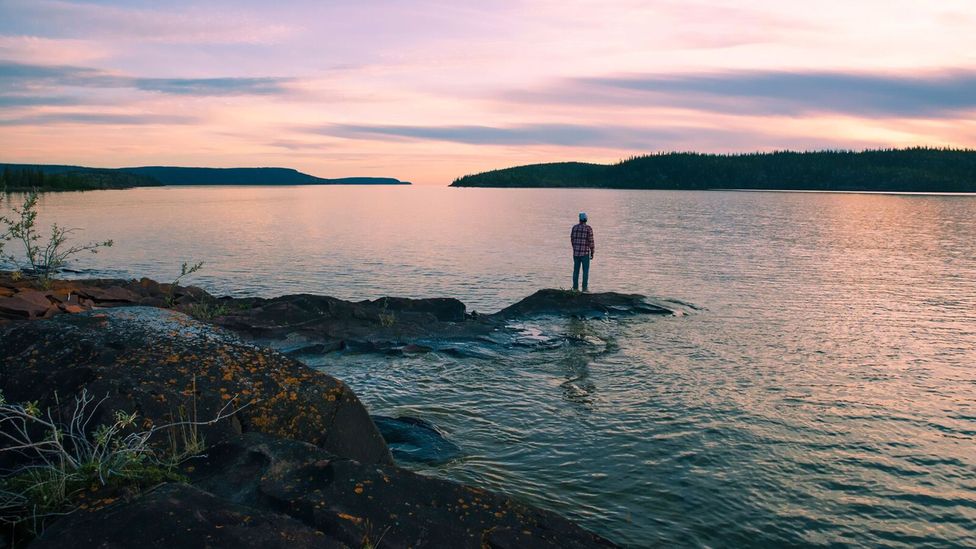Every year, when the frozen streams have melted and greenery emerges after months of winter stillness, Dolcy Meness knows it's time. Packing their truck, she and a colleague set off through the densely forested hills of Kitigan Zibi Anishinabeg territory, an Algonquin First Nation in the province of Quebec.
After a few hours they reach their destination. Parking the truck, they make their way through forest until reaching a narrow stream. Kneeling on its mossy bank, Meness carefully places a small device in the water.
Over a period of one year, the device will collect data on the water's temperature, PH, salinity and conductivity.
But even before any data is gathered, Meness and her colleague are on the look out for indications that something is off. Seeing an unusually high amount of sand in streams – which leaks into the water from logging roads – is one sign they look out for, based on indigenous knowledge, says Meness.
"Brook trout use creeks, but they like rocks. Sand isn't a good breeding place for them, so they have to look for a different place. It creates a change that shouldn't be there," she says.
Using a "two-eyed seeing approach", Meness and fellow Nagadjitòdjig Akì guardians draw on the strengths of indigenous knowledge alongside Western science to monitor the impacts of extractive industries, like logging, on their territory.
Being in this job gives me in-depth knowledge about my own history, culture and teachings. [It's] a long journey of re-learning – Dolcy Meness
By collecting data on water quality in streams and rivers, they help determine if companies are adhering to regulations.
"We can go to them and say: 'You're not doing your job properly, you're destroying creeks when you're logging, you're not following your own rules,'" says Meness.
Over the year, Meness and her colleagues will repeat their data gathering task many times. Working alongside non-governmental organisations, they're responsible for 50 sites throughout the Ottawa River watershed, which encompasses Kitigan Zibi traditional territory.
They are also part of a flourishing movement of 1,000 "Indigenous Guardians" across Canada who are stewarding their traditional lands and waters and redefining what conservation can – and many argue should – look like.
Amidst global ecological collapse, which some scientists call the "sixth mass extinction", there is increasingly widespread acknowledgement that indigenous people can demonstrate a more sustainable path forward – one that other societies could learn from. This is due to both their relationship with the environment, based on respect and reciprocity, and their substantial but often undervalued contributions to biodiversity conservation.
In Canada, where there are feelings among many that colonialism is a historical problem but one still rooted in the present, centring conservation with the country's original stewards is allowing indigenous people to reconnect to their land and culture. It is also reshaping relations between indigenous nations and non-indigenous Canada, presenting an opportunity for genuine reconciliation.
"Being in this job gives me in-depth knowledge about my own history, culture and teachings," says Meness. "[It's] a long journey of re-learning."
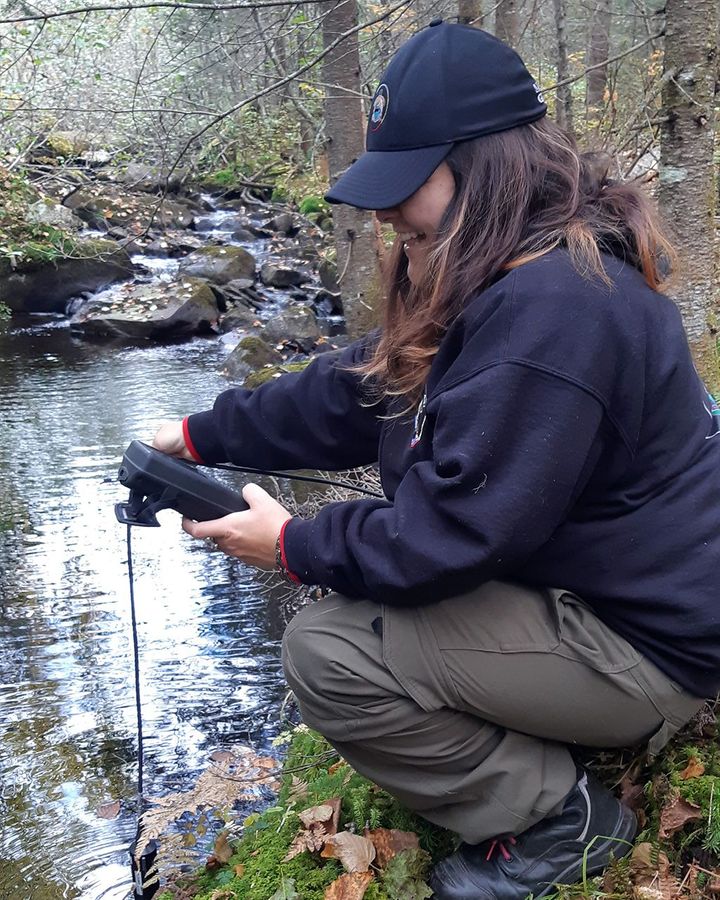
Serving as the "eyes and ears" on traditional territories, guardians are trained experts responsible for supporting stewardship of lands and waters (Credit: Dolcy Meness)
Stretching from the Pacific to the Atlantic to the Arctic Ocean and encompassing 15 terrestrial ecozones, Canada is blessed with ecological wealth. The country contains 28% of the world's boreal forest, while 25% of global temperate forests are located in the province of British Columbia alone. The country is home to an estimated 80,000 species, 25% of the planet's wetlands, 20% of global surface freshwater and the world's longest coastline.
Like elsewhere, this biodiversity is threatened by habitat loss and degradation, over-exploitation, pollution and climate change. The most recent national assessment found 20% of measured species face some level of risk of extinction, with 873 of these species critically endangered mainly due to human activities encroaching their habitat.
Canada, which hosted the UN Cop15 biodiversity summit last December, has set ambitious targets to halt biodiversity loss. Currently, 12.7% of Canada's land and 9.1% of its oceans are classed as protected areas. The federal government has committed to protecting 25% of Canada's oceans, land and freshwater by 2025 and working towards 30% by 2030, in line with the global goal of protecting 30% of the Earth by that year.
There's too often this idea that indigenous people need shepherding or some sort of management or middle ground of translation. It's really important to trust us – Valérie Courtois
But even with a committed government, achieving these targets on time in the world's second-largest country is a tall order. According to indigenous and non-indigenous experts alike, these targets won't be reached without recognising the effectiveness of indigenous-led conservation initiatives.
"We have to more than double the national network of these areas to meet our targets by 2030," says Valérie Courtois, a member of the Ilnu Nation and director of the Indigenous Leadership Initiative. "The only way that Canada is going to be able to do that is by enabling, supporting and financing the work of indigenous peoples."
Indigenous protection models are not new, says Alison Woodley, senior strategic advisor for the Canadian Parks and Wilderness Society, "But the elevation and recognition of [them] in society and by crown governments are fairly recent."
Since the late 1990s, the vast majority of protected areas established in Canada have been led or co-led by indigenous peoples, says Courtois, and their ambitions far exceed those of governments and global targets.
"On average in Canada, when indigenous peoples are holding the pen, we see 60% plus protection of their landscape," she says.
There's no shortage of examples of indigenous-led conservation ambition, from the Qikiqtani Inuit Association working to establish a 108,000 sq km (42,000 sq miles) national marine conservation area in the richly diverse Arctic waters offshore of Nunavut to the Sayisi Dene First Nation in northern Manitoba aiming to protect the entirety of the 50,000sq km (19,300sq miles) Seal River watershed.
It is still early days for initiatives like these, but they are showing some signs of progress. Following a campaign by the Sayisi Dene and three other First Nations, both the Canadian and Manitoba governments have agreed to conduct feasibility studies on whether to establish the Seal River watershed as an Indigenous Protected and Conserved Area.
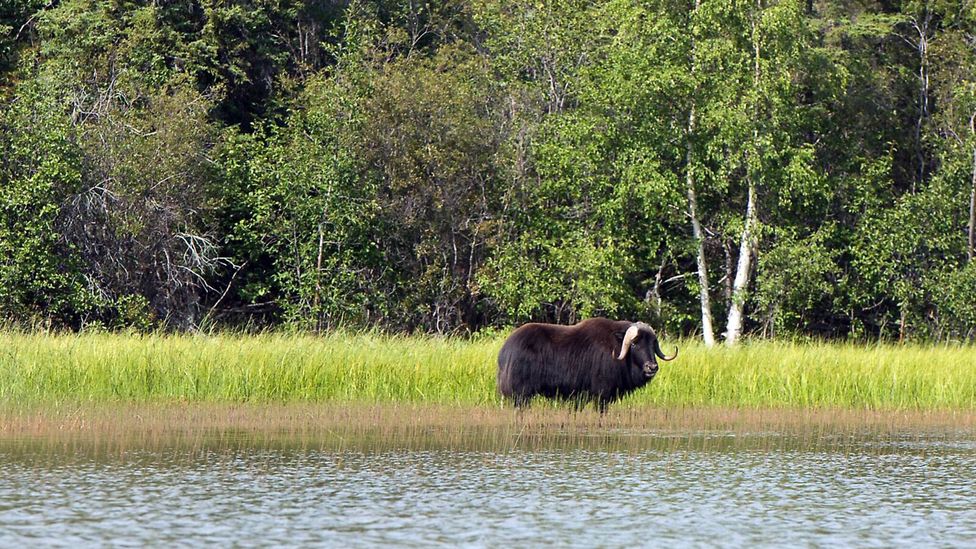
Thaidene Nëné Indigenous Protected Area, designated by the Łutsël K’é Dene First Nation under Dene Law in 2019. It covers 26,000 sq km (10,000 sq miles) (Credit: Pat Kane Photo)
Across the country, First Nations have proposed Indigenous Protected and Conserved Areas (IPCAs) – which are rooted in indigenous laws, governance and knowledge systems – that together could conserve over 500,000 sq km (193,000 sq miles), with more proposals continuing to be made.
The rapid growth of Indigenous Guardians programmes, overseen by the Indigenous Leadership Initiative, demonstrates the momentum behind indigenous-led conservation in Canada. Five years ago, there were 30 programmes. Today, there are over 120, across every province and territory.
And there would likely be many more – if the money was there. At the last intake, Courtois says demand for guardians programmes far outweighed available funding.
"But it's not just about lines on a map," says Courtois. "What really matters is our relationship with those places."
Serving as the "eyes and ears" on traditional territories, guardians are trained experts responsible for helping indigenous nations steward their lands and waters. Guardians manage protected areas and restore wildlife and plants. They are central to creating land-use and marine-use plans. And they test water quality and monitor resource development.
Guardians programmes are also vital in connecting youth with elders, facilitating the transmission of indigenous languages, culture and traditional knowledge – helping indigenous nations to recover and reclaim what has been diminished by colonisation.
You might also like:
- The traditions that could save a nation's forests
- Seawilding: the Scottish community reviving a loch
- The white roofs cooling women's homes in Indian slums
Working as a guardian has enriched Meness' life with new experiences and knowledge. From elders she has learnt how to build birch bark canoes and identify medicinal plants. Once, in a remote camp, a woman had been burnt and Meness, given this expertise, was called upon to help. Gathering yarrow, which has cooling effects, and winter green, which soothes inflammation and pain, she mashed them together in a bowl, thinning the mixture ever so slightly with river water. A few minutes after applying the paste to the burn, the woman felt relief, says Meness.
Witnessing their ancestor's knowledge in action was, she recalls, a profound moment that deepened her interest in medicinal plant knowledge. "We [once] used all these plants. That's what they were made for, to help us," she says.
In turn, Meness now offers medicine walks and workshops, and aims to play an integral role disseminating this knowledge to others in her community.
"Guardians is a job [that allows you to] be who you are fully, embrace your values and approaches and be a part of the modern wage economy," says Courtois. "And those benefits trickle right down through the community and nations. I think it's an incredibly powerful healing force."
Emerging out of and healing from the colonial experience – cultural genocide, residential schools, attempted assimilation – takes time, she says, and Canada's guardians are key to that.
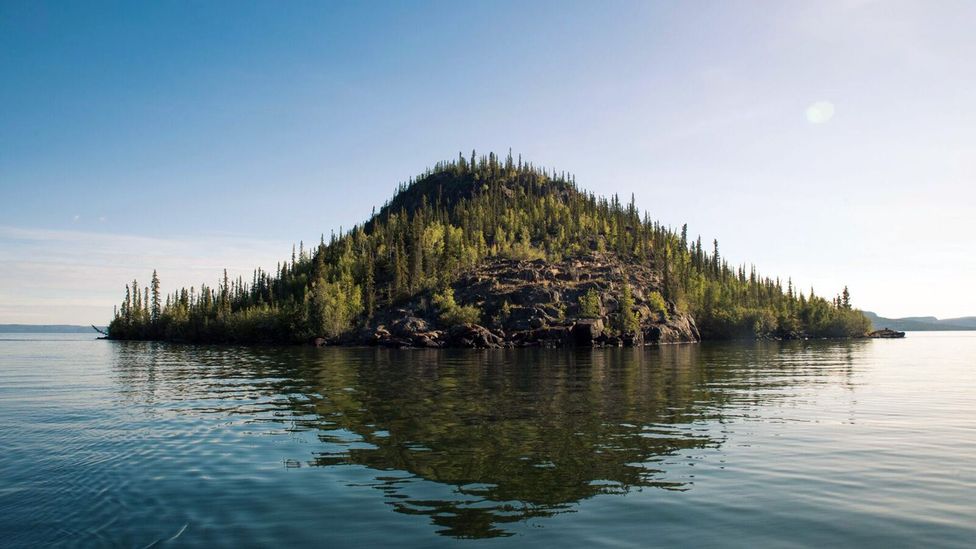
Thaidene Nëné Indigenous Protected Area sits in Canada's Northwest Territory, where boreal forest transitions to Arctic tundra (Credit: Pat Kane Photo)
An analysis of two programmes in the Northwest Territories found Canada's guardians benefitted from increased skills, confidence and pride, better health and wellbeing, and higher income. For communities, the programmes led to higher participation in self-governance, strengthened relationships with land and water, more role models for youth and reduced crime rates.
Each Canadian dollar invested in the programmes has been shown to generate CAD$2.50-3.70 ($1.90-2.80/£1.50-2.20) of social, cultural, economic and environmental benefits. And an analysis in British Columbia found that the Coastal Guardians Watchmen programmes in seven First Nations achieve up to a 20-to-one annual return on investment. Elsewhere, research from Australia – which has a similar indigenous rangers programme – yielded positive results too, with each Australian dollar invested generating more than AUS$3 ($2/£1.60) in benefits.
The effectiveness of indigenous-led conservation is increasingly gaining visibility.
One 2019 study found indigenous-managed lands in Canada, Australia and Brazil were slightly richer in birds, mammals and amphibians than protected areas and, in Brazil and Canada, supported more threatened vertebrates than protected or non-protected areas. Globally, indigenous lands make up around 20% of the Earth's territory yet hold 80% of remaining biodiversity.
Indigenous peoples worldwide are still fighting for basic recognition of their rights and are frequently harassed, criminalised, assaulted or killed for defending their territories
"We know these areas because our survival has depended on them for thousands of years, in my nation's case for at least 10,000 years," says Courtois. "Clearly, we're doing something right, having been a sustainable society for all that length of time. There's a real opportunity to share that knowledge [and] for knowledge gaps to be filled."
Indigenous-led conservation differs starkly from the "fortress conservation" approach that dominated global conservation policy for over a century. Following decades of work by indigenous activists, rights monitors and advocacy groups, there is growing recognition that conservation ideals based on the exclusion of people from landscapes fail to recognise the benefits that indigenous and local people often have on their environment.
Meanwhile, indigenous peoples worldwide are still fighting for basic recognition of their rights and are frequently harassed, criminalised, assaulted or killed for defending their territories.
The Global Biodiversity Framework adopted at Cop15 made small steps forward by recognising and respecting the rights of indigenous peoples. But the agreement didn't incorporate indigenous people's demand for their lands and territories to be fully recognised as a specific category of conserved area – meant to protect them from land evictions and abuses. This exclusion leaves them at greater risk of human rights violations, according to human rights non-profit Amnesty International.
"Although the new forms of recognition in the Global Biodiversity Framework are a high watermark, it is by no means enough," says Holly Jonas, global coordinator of the ICCA Consortium, an international non-profit which supports Indigenous Peoples' and Community Conserved Areas and Territories (ICCAs).
"Governments continue to have a two-faced approach to environmental law and policy-making, perpetuating the status quo while throwing out some positive-sounding breadcrumbs here and there."
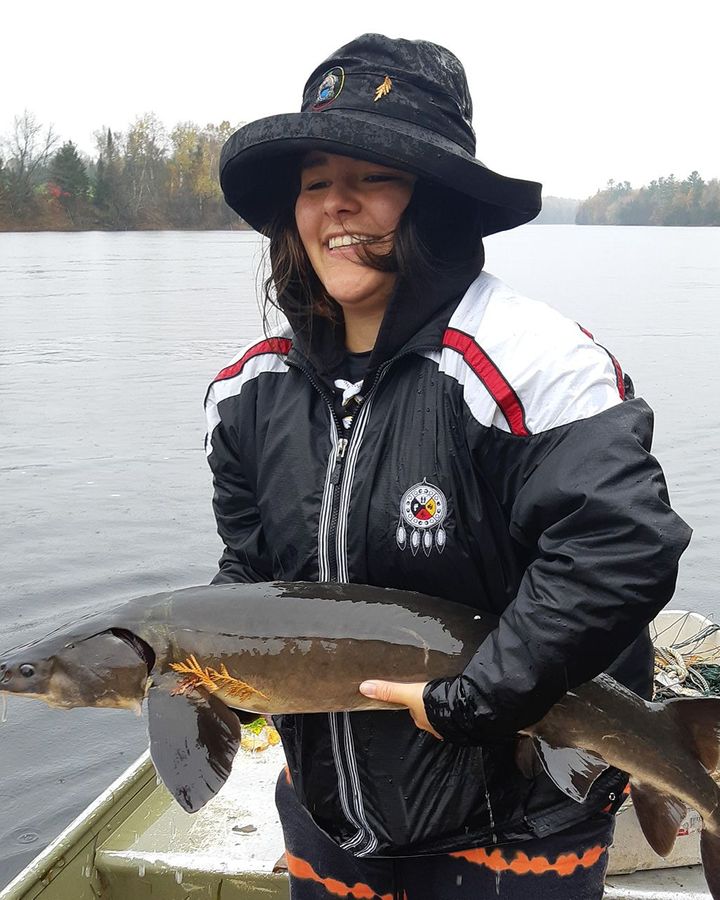
Dolcy Meness fishing in her nation’s traditional territory, Kitigan-Zibi-Anishinabeg (Credit: Dolcy Meness)
Back in Canada, things have come a long way – but, says Jonas, "the government's efforts still pale in comparison to what should or could be done to support indigenous nations".
Indigenous and non-indigenous experts note several barriers hindering further progress. Chief among them, says Courtois, is systemic racism. "There are a number of stereotypes that are perpetuated and enshrined in Canadian society about indigenous peoples. And that's a battle we address daily in the work we're doing."
Despite existing for millennia and embodying a wealth of wisdom, indigenous knowledge systems often still struggle for recognition.
"Western science tends to say: 'We're fact-based, we should lead in decision-making,'" says Courtois. "There's not always a recognition of equivalency of indigenous science to that. And while some may say that they believe in indigenous science, where Western science and indigenous science clash, guess who wins in this system?"
During Cop15, Courtois and the Canadian federal government announced the establishment of the First Nations National Guardians Network – a global first – to expand and support guardians programmes. It's hoped the network will help address funding stability, which until now has remained a gap. The Indigenous Leadership Initiative wants permanent federal investment in guardians programmes to maximise their impacts.
"Our goal is that every First Nation, Inuit or Métis community in Canada that wants a guardians programme should be able to have one," says Courtois. "We think the country would be transformed for the better as a result of those investments."
Courtois hopes Canada can serve as a model to other parts of the world – on the art of the possible when it comes to decolonisation and reconciliation. But she cautions against the indigenous-led conservation movement being used to reinforce a colonial apparatus.
"There's too often this idea that indigenous people need shepherding or some sort of management or middle ground of translation," she says. "It's really important to trust us. We know what we're doing. It's about time we have our place in global society."
Carbon Count
The emissions from travel it took to report this story were 0kg CO2. The digital emissions from this story are an estimated 1.2g to 3.6g CO2 per page view. Find out more about how we calculated this figure here.
After Meness and her colleague have ensured the water monitoring device is in place and recording data in Kitigan Zibi Anishinabeg territory, they begin the trek back to the truck.
The Sun is sinking lower in the sky and there's a long drive home. Tomorrow will bring another day out on the land, stewarding the territory as her ancestors once did, and as generations to come will too.
Meness senses a shift in society, observing that indigenous and non-indigenous people alike are trying to work together. In that shift, hope has taken root.
"People are actually listening now," she says. "Being a guardian means to me that [indigenous] people will never go away. We'll always be here. Stop trying to go against us and start working with us."
--
Join one million Future fans by liking us on Facebook, or follow us on Twitter or Instagram.
If you liked this story, sign up for the weekly bbc.com features newsletter, called "The Essential List" – a handpicked selection of stories from BBC Future, Culture, Worklife, Travel and Reel delivered to your inbox every Friday.
